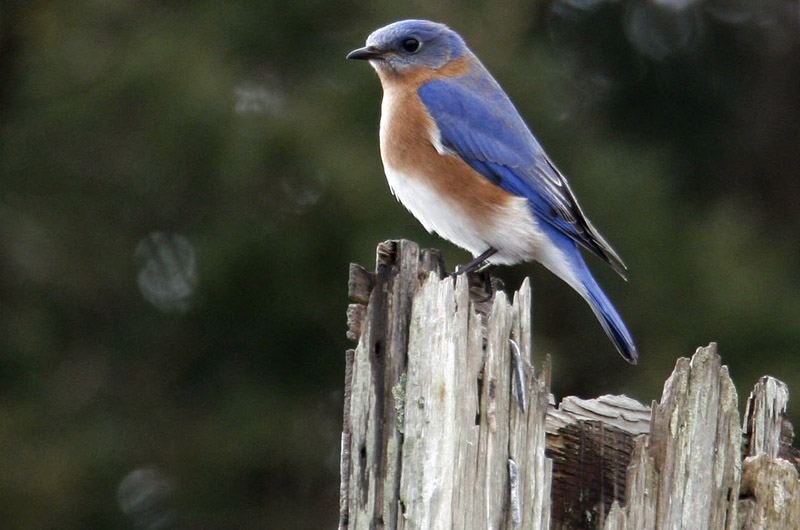By my way of thinking, winter finally arrived on the evening of Jan. 17, with the arrival of the storm that produced about two inches of wet snow. By the morning of Jan. 18, the ground was covered with the white stuff, and most branches were laden with snow. And the forecast was for temperatures to stay around freezing, with a chance of more snow this weekend.
Winter’s arrival can affect birds in many ways. The cold temperatures, often with strong winds, mean that it will be more difficult for birds to maintain their body temperatures. They will need a reliable source of food to do this. Yet snow covering the ground can conceal the food that is on the ground or in the leaf litter. This food is not accessible to your average bird which is not able to dig through the snow. And the snow on branches can also conceal the food that chickadees and other woodland birds need to find.
With food more scarce in the wild, the seed and suet provided at bird feeders can be the difference between survival and the other alternative. During the fall, birds learn where the food is in their territory, including at bird feeders; food they are counting on to get them through the cold and snowy nights. Those who feed birds must continue to put out food for them now, when our feathered friends need it the most.
Many people have commented that they have had fewer birds coming to their feeders. That will change now, with snow on the ground. We will have more birds coming to our feeders and they likely will stay longer, consuming more seed. This larger number of birds may have been here all along, getting all their food from the wild. Or they may be recent arrivals, forced southward by the arrival of wintery weather further to our north.
As if on cue for this column, Lanny McDowell observed chipping sparrows at his feeder on Jan. 18. They have been scarce this winter. Their sudden presence at his feeder is due to the snow covering their usual food on the ground.
Bird Sightings
The bird of the week is the lesser black-backed gull that Ken Magnuson found in with a flock of herring gulls at Katama in the strong winds and rain of Jan. 16. In stormy weather gulls often gather in fields and pastures, where it generally is more protected than their usual haunts on our beaches. Unusual gulls are possibly mixed in with the flock. Lessers used to be very unusual, but sightings have become more frequent within the past five years. However, they seem to be most common in the summer and fall. This is a new species for the calendar year. We looked long and hard for this species on the recent Christmas Bird Count, but were unsuccessful.
Mr. Magnuson also reports a northern pintail and a snowy owl at Edgartown Great Pond on Jan. 17. The owl is possibly the same one that has been frequenting Norton Point and Chappaquiddick these past few weeks. That same day he also observed a red-necked grebe in Menemsha Bight off Lobsterville. This is another species that was not observed on the Christmas Bird Count (it had been seen on every count since 1977), although in January, Allan Keith has seen one twice at Squibnocket.
Mr. Keith also reports a new species for the new year, a dickcissel, which visited his feeder on Jan. 13. He has not seen it since then, but it could easily be hiding out in several nearby flocks of house sparrows. We do not expect to see them at this time of the year, and they are never common at any time of the year.
Albert Fischer found a pied-billed grebe at Squibnocket Pond on Jan. 17.
The large flock of greater scaup is still on Lagoon Pond. Matt Pelikan’s crew counted 160 of them on the Bird Count, and Lanny McDowell found them again near the drawbridge on January 16.
The Pacific loon is still around. Mr. McDowell found it along with 16 common loons off the Lobsterville Beach near the Menemsha jetties on January 16. He also found two black-legged kittiwakes in Menemsha channel; this normally pelagic gull may be there because of the ongoing dredging of the channel.
Sharon Simonin found an immature great blue heron near the drawbridge on Jan. 15. Also on that day, Susan Straight saw a pair of harlequin ducks at Squibnocket Beach.
Eastern bluebirds have not been very common in recent months. Gus Ben David reports that he had a flock of six flying over his house this past week, the first he had seen there since two broods were fledged last summer.
On Jan. 17, in the rain, Happy and Steve Spongberg found a roost of about 30 or 40 turkey vultures near Seven Gates Farm. Most of the birds were perched on a roof, with their wings outspread as if they were cormorants. “Very creepy,” writes Ms. Spongberg.
Last, but not least on this wintery day, EL Edwards reports that two pine warblers have been visiting his feeders this week. They are one of the hardier of our warblers, and are not uncommon at this time of the year.
There are lots of birds around, so please get out looking for them, and be sure to report your bird sightings to birds@mvgazette.com.
Robert Culbert leads guided birding tours and is an ecological consultant living in Vineyard Haven.





Comments
Comment policy »